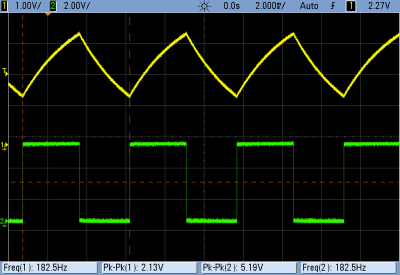Today we’ll take a journey into less noisy noise, and leave behind the comfortable digital world that we’ve been living in. The payoff? Smoother sounds, because today we start our trip into analog.
If you remember back to our first session when I was explaining how the basic oscillator loads and unloads a capacitor, triggering the output high or low when it crosses two different thresholds. At the time, we pointed out that there was a triangle waveform being generated, but that you’d have a hard time amplifying it without buffering. Today we buffer, and get that triangle wave out to our amplifiers.

But as long as we’re amplifying, we might as well overdrive the amps and head off to the land of distortion. We’ll do just that and build up a triangle-wave oscillator that can morph into a square wave, passing through a rounded-over kinda square wave along the way. The triangle sounds nice and mellow, and the square wave sounds bright and noisy. (You should be used to them by now…) And we get everything in between.
And while we’re at it, we might as well turn the triangle wave into a sawtooth for that nice buzzy-bass sound. Then we can turn the fat sawtooth into a much brighter sounding pulse wave, a near cousin of the square wave above.
What’s making all this work for us? Some dead-boring amplification with negative feedback, and the (mis-)use of a logic chip to get it. After the break I’ll introduce our Chip of the Day: the 4069UB.
If you somehow missed them, here are the first three installments of Logic Noise:
Continue reading “Logic Noise: Sawing Away With Analog Waveforms” →
















